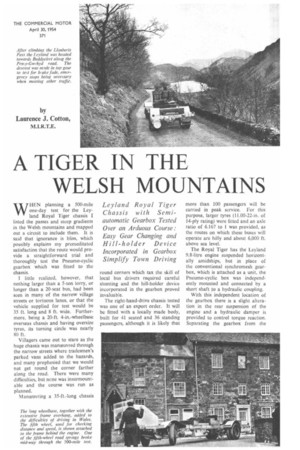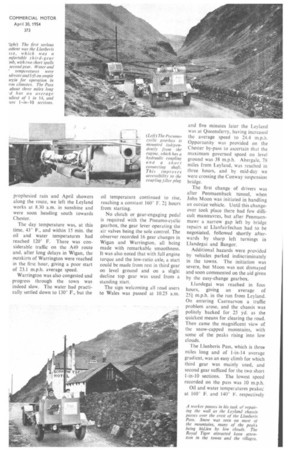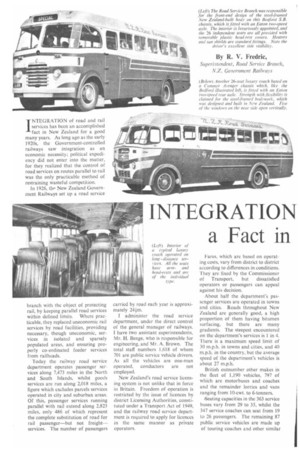A TIGER IN THE WELSH MOUNTAINS
Page 115

Page 116

Page 117

Page 118

Page 119

Page 120

Page 121

If you've noticed an error in this article please click here to report it so we can fix it.
WHEN planning a 500-mile one-day test for the Leyland Royal Tiger chassis I listed the passes and steep gradients in the Welsh mountains and mapped out a circuit to include them. It is said that ignorance is bliss, which possibly explains my premeditated satisfaction that the route would provide a straightforward trial and thoroughly test the Pneumo-cyclic gearbox which was fitted to the chassis.
1 little realized, however, that nothing larger than a 5-ton lorry, or longer than a 20-seat bus, had been seen in many of the narrow village streets or tortuous lanes, or that the vehicle supplied for test would be 35 ft. long and 8 ft. wide. Furthermore, being a 20-ft. 4-in.-wheelbase overseas chassis and having oversize tyres, its turning circle was nearly 80 ft.
Villagers came out to stare as the huge chassis was manceuvred through the narrow streets where tradesmen's parked vans added to the hazards, and many prophesied that we would not get round the corner farther along the road. There were many difficulties, but ncne was insurmountable and the course was run as planned.
Manceuvring a 35-ft.-long chassis round corners which tax the skill of local bus drivers required careful shunting and the hill-holder device incorporated in the gearbox proved invaluable.
The right-hand-drive chassis tested was one of an export order. It will be fitted with a locally made body, built for 41 seated and 36 standing passengers, although it is likely that more than 100 passengers will be carried in peak service. For this purpose, larger tyres (11.00-22-in. of 14-ply rating) were fitted and an axle ratio of 6.167 to 1 was provided, as the routes on which these buses will operate are hilly and about 6,000 ft. above sea level.
The Royal Tiger has the Leyland 9.8-litre engine suspended horizontally amidships, but in place of the conventional synchromesh gearbox, which is attached as a unit, the Pneumo-cyclic box was independently mounted and connected by a short shaft to a hydraulic coupling.
With this independent location of the gearbox there is a slight alteration in the rear suspension of the engine and a hydraulic damper is provided to control torque reaction. Separating the gearbox from the engine has afforded easier access to the hydraulic coupling to check the oil level and to adjust the gland packing nut.
A recent innovation is the use of a metal shield around the power unit, which keeps out dirt, and serves the dual purpose of improving oil and water temperatures. The radiator is mounted below frame level behind the front axle and a header tank is now included. Cambridge tube thermometers were put in the water outlet pipe and down the engine oilfiller neck, the dials being attached to the gear-lever pedestal, so that operating temperatures could be recorded during the trials.
The purpose of the test was mainly to observe the virtues or disadvantages of the semi-automatic gearbox_ This unit has been developed by Leyland Motors, Ltd., in conjunction with Self Changing Gears, Ltd., and is of the compound epicyclic pattern with a brake band and compressedair piston to each band and corresponding gear train.
In place of the conventional gear lever there is a small unit containing five air valves, each valve being the operating unit for a forward or reverse gear. Compressed air is fed from a reservoir to the control unit and movement of the lever causes one of the live valves to open, permitting the air to pass to the piston, which, in turn, operates through a toggle lever to lock the brake band on the drum. Small air bleeds are interposed near the piston to provide a smooth and continuous take-up of drive during gear changes.
The Pneumo-cyclic gearbox has been designed specially for interchangeability of parts and to be competitive in price with any other type of fully or semi-automatic drive. It is robust, yet reasonably light, and is rated for 550 lb.-ft. torque input.
Leyland Motors, Ltd., provided the chassis at short notice, the day between final assembly and my test being occupied by fitting an observer's seat, the thermometers, lamps and some moderate protection against foul weather for the crew. Immediately before starting it was recalled that the fuel-injection-pump setting had been calibrated for operation at 6,000 ft. above sea level and hurried adjustments were made to re-set for normal output.
Complete with body and 40 seated passengers, the 35-ft.-long Royal Tiger weighs about 11 tons, and iron castings were bolted to the chassis to give approximately this figure. A normal 30-ft. coach with passengers and luggage would weigh about 101 tons, consequently my test would be comparable with the conditions of operation of a long-distance tour in the Welsh mountains, with the exception that smaller tyres and a higherratio axle might be used.
1 was accompanied by a Leyland representative, Mr. G. Ranger, and John F. Moon, of The Commercial Motor, who were on the rota for driving and observing on the chassis and assisting with the photographer's car. Although the weather forecast prophesied rain and April showers along the route, we left the Leyland works at 8.30 a.m. in sunshine and were soon heading south towards Chester.
The day temperature was, at this time, 43' F., and within 15 min. the oil and water temperatures had reached 120° F. There was considerable traffic on the A49 route and, after long delays in Wigan, the outskirts of Warrington were reached in the first hour, giving a poor start of 23.1 m.p.h. average speed.
Warrington was also congested and progress through the town was indeed slow. The water had practically settled down to 130° F., but the
oil temperature continued to rise, reaching a constant 160' F. 21 hours from starting.
No clutch or gear-engaging pedal is required with the Pneumo-cyclic gearbox, the gear lever operating the air valves being the sole control. The observer recorded 16 gear changes in Wigan and Warrington, all being made with remarkable smoothness. It was also noted that with full engine torque and the low-ratio axle, a start could be made from rest in third gear on level ground and on a slight decline top gear was used from a standing start.
The sign welcoming all road users to Wales was passed at 10.25 a.m. and five minutes later the Leyland was at Qucensferry, having increased the average speed to 24.4 m.p.h. Opportunity was provided on the Chester by-pass to ascertain that the maximum governed speed on level ground was 38 m.p.h. A bergale. 78 miles from Leyland, was reached in three hours, and by mid-day we were crossing the Conway suspension bridge.
The first change of drivers was after Penmaenback tunnel, when John Moon was initiated in handling an outsize vehicle. Until this changeover took place there had few difficult manceuvres, but after Penmaenmawr a narrow gap left by bridge repairs at Llanfairfechan had to be negotiated, followed shortly afterwards by sharp left turnings in Llandegai and Bangor.
Additional hazards were provided by vehicles parked indiscriminately in the towns. The initiation was severe, but Moon was not dismayed and soon commented on the aid given by the easy-change gearbox.
Llandegai was reached in foot hours, giving an average of 251 m.p.h. in the run from Leyland. On entering Caernarvon a traffic problem arose, and the chassis was politely backed for 25 yd. as the quickest means for clearing the road. Then came the magnificent view of the snow-capped mountains, with some of the peaks rising into low clouds.
The Llanberis Pass, which is three miles long and of 1-in-14 average gradient, was an easy climb for which third gear was mainly used, and second gear sufficed for the two short 1-in-10 sections. The lowest speed recorded on the pass was 10 m.p.h.
Oil and water temperatures peaked at 160° F. and 140° F. respectively
during this climb, the ambient reading being 50°F. This was sufficient to indicate that the Royal Tiger is adequately cooled for operation in warmer climates.
There had been eight minutes' delay in Caernarvon, which reduced the average speed of the fifth hour's driving to 22 m.p.h. and the climb and descent of the Llanberis Pass again slowed down the pace for the next period. The sharp right turn on to the A498 road at Pen-yGwyhyd was accomplished without need to reverse and we were soon travelling at fair speed down towards lBeddgelert. Smoke was rising from the brake drums after an emergency stop well down the hill, but the retardation was notably effective. At Tremadoc an acute turn on to an unclassified road provided a ticklish manoeuvre, and the chassis was shunted several times before clearing a narrow bridge.
Soon after passing the toll gates at Portmadoc, the Leyland was climbing Maentwrog, which is a mile long of 1 in 10 average gradient and has sections alleged to be 1 in 6. It appeared much more severe than expected, perhaps because of falling ground on one side, yet it was climbed comfortably in second gear and a stop-start trial made without moving the gear lever.
Trawsfynydd was notable for its narrow village street, and for the tradesmen's vans and lorries which caused long delays. Many of the villagers appeared never to have seen a chassis before, and were curious to know whether any more such monstrous things would be passing through to disturb their bliss.
After a seven-minute delay, the chassis was headed towards Dolgelley, where 15 gallons of fuel were added to the tank. This gave an average of just under 12 m.p.g. at 25.2 mph. average speed, including all stops.
Just outside Dolgelley a halt was called for a belated lunch, and then I took control to drive towards Dinas Mawddy and climb the 11-mile-long Bwlch Oerddrws (Cross Foxes). This is a steady 1-in-12 incline, where third gear sufficed, except for brief spells of second gear for the 1-in-6 and 1in-8 sections. After cooling during the meal halt, the oil and water temperatures were still below normal working level at the summit.
At Dinas Mawddy we turned off towards Cammaes to join the A487 route and indulge in further climbs at Aberystwyth. Rhinshonsaer Hill, two miles before the town, is half-amile long of 1-in-8 average and 1-in5 maximum gradients, and here the lowest ratio was used for the first time.
On entering the town by PenGlaise Road. there was another f-mile of 1 in 8, which was taken comfortably in third gear. These two successive climbs brought the oil temperature to 160° F. and the water to 130° F. Then came a steady drive alongside Cardigan Bay before turning inland at Aberayron to meet the A486 route at Synod.
The Automobile Association itinerary describes the 18 miles between Synod and Cwm Duad as "extremely hilly with ascents and descents of 1 in 7 to 1 in 12." This it proved to be, and, ignoring other inclines of less than 1-in-12 gradient, the Leyland faced 11 miles of severe work. Third gear was used for best part of the way and second was employed only when the engine speed fell t o approximately 900 r.p.m.
A shunt turn was made at the junction of A484 and A40 on the fringe of Carmarthen and then followed a fast run along the main road to Llandovery, which was a crew-changing point.
Third gear was tending to slip on engagement, and an adjustment was made on the spot by moving the lever from neutral to third position about a dozen times. This corresponds, in effect, to "pumping up" on the gear engaging pedal with a conventional pre selective epicyclic gearbox, operating the automatic adjustment nut of the brake band.
Progress in the dark from Llando very was made more unpleasant by driving rain, which persisted practically all the way back to Leyland. The Sugar Loaf Pass, which is about 1 miles long, was a steady third-gear climb and then there were several short hills of 1 in 7 to 1 in 9 to Builth Wells.
Oswestry was reached at midnight, where there was the final change of drivers. The Leyland tackled the Horseshoe Pass at speed, but bottom gear was required briefly at the 1 in 5 bend just above the Britannia Inn. Apart from this it was a second-gear climb and half-way up the hill we reached cloud level, which reduced visibility to about 25 yd.
The running temperatures at
Llangollen, were 120° F. for the water and 130° F. for the oil, but after two miles steady climbing up the Pass they rose to 145° F. and 155° F. respectively. Within 15 minutes we were again climbing, this time Bwlch Hill, which is 21 miles long and almost as severe as the Horseshoe Pass. This was a second-gear effort, but caused no further rise in the oil or water temperatures. The Royal Tiger covered 488 miles before reaching Leyland at 3.45 a.m., 191 hours after leaving the works. When refuelling, 27 gallons were added to bring the level to overflow point, corresponding to 11.62 m.p.g. for the entire route. After deducting the time of the meal stops, the average speed worked out to 27.9 m.p.h. The fuel-consumption rate and average speed were most satisfactory for such an arduous trial. There was ample power on all the gradients and the cooling was adequate for warmer climates. The Pneumo cyclic gearbox was invaluable in town or mountain driving, and the hillholder device worked efficiently. Further performance trials were conducted later in the morning over fairly level ground on the Southport road. 1.t is customary when making emergency stops to disengage the drive, through the clutch or gearengaging pedal, at the same time as maximum pressure is put on the brake pedal. There is no gear. engagingpedal with the Pneumocyclic gearbox, so the tests were extended to stop with the drive engaged and subsequently with the lever in a neutral position. Slightly better results were obtained with a gear engaged. Although these trials were conducted in heavy rain, there was no wheel-locking, but the chassis was stopped in 25 ft. from 20 m.p.h. and 551 ft. from 30 m.p.h. The hand brake was particularly effective and the Tapley readings ranged from 35-40 per cent. from 20 m.p.h. The design of the gearbox enables the drive to be continued between changes in ratio. From the time of starting to the engagement of top gear there is no harsh take-up in transmission, which improves passenger comfort and lengthens the life of the propeller shafts and rear-axle components. The Royal Tiger has fast acceleration, as was shown by reaching 30 m.p.h. in 23.9 sec. from a standing start when using the second, third and fourth ratios, and by reaching 30 m.p.h. from 10 m.p.h. in direct drive in 24 sec.
Driving at a steady speed, the fuel return over an 8.2-mile circuit was 14.25 m.p.g. at 29.1 m.p.h. With the low ratio of the axle, the chassis was over-powered for operation on level ground and it is possible that greater economy would have been achieved with one of the higher ratios. rn simulating service conditions, fuel returns of 12.36 m.p.g. and 8.2 m.p.g. were obtained with one and four stops per mile respectively.
(Left) The Road Service Branch was responsible for the front-end design of the steel-framed New Zealand-built body on this BedJima S.B. chassis, which is fitted with an Eaton two-speed axle. The interior is luxuriously appointed, and the 26 independent seats are all provided with removable plastic headrest covers, Heaters and sun shields are standard fittings. Note the driver's excellent side risibility.
By R. V. Fredric,
Superintendent, Road Service Branch, N.Z. Government Railways (Below) Another 26-seat luxury coach based on a (wanner Avenger chassis which, like the Bedford illustrated left, is .fitted with an Eaton two-speed rear axle. Strength with flexibility is claimed .for the steel7framed bodywork, which was designed and built in New Zealand. Five of the windows on the near side open vertically.
types. All are fitted with metal bodies manufactured in New Zealand.
Restrictions on vehicle dimensions are generally similar to those applicable in Britain (length 30 ft. and width 8 ft.), but special permission for a maximum length of 33 ft. can be obtained for passenger vehicles intended for operation on selected routes. Standing capacity generally must not be greater than four-thirds of the number of seats, but in buses with double rear exit doors the maximum is slightly higher.
The performance of the British vehicles, which include such makes as Bedford, Commer and Leyland, is good, and their average petrol consumption at approximately 8 m.p.g. compares exceptionally well with the 7-8 m.p.g. returned by oil-engined American Mack buses.
Bus stops are sited at intervals of approximately a fifth of a mile, except in towns and cities and on Peak periods in the large towns and cities are a problem which the department shares with operators in most parts of the world. The maximum working fleet is brought into operation to cope with the daily peaks, which extend from 7 a.m. to 9 a.m., and from 4.30 p.m. to 6.30 p.m. The demand for vehicles during the day tapers off by about a half.
Although the erection of modern bus terminals is envisaged at a future date, the backlog of housing and industrial development has restricted the department's plans in this sphere in recent years. There are, however, modern garages in Auckland, Wellington, Christchurch and Dunedin, and facilities for subsidiary repair and maintenance work are provided at all terminal points.
Only qualified mechanics, many of whom completed their apprenticeships in the department's own workshops, are employed on vehicle




















































































































































































































































